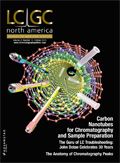Peaks of Interest
The Eastern Analytical Symposium (EAS) will be held this year from November 18 to 20, 2013, in Somerset, New Jersey. EAS is the second largest conference and exposition for laboratory science in the United States dedicated to the needs of analytical chemists and those in the allied sciences.
EAS Conference Preview of Chromatography Sessions and New Features
Justin Pennington, 2013 Program Chair
The Eastern Analytical Symposium (EAS) will be held this year from November 18 to 20, 2013, in Somerset, New Jersey. EAS is the second largest conference and exposition for laboratory science in the United States dedicated to the needs of analytical chemists and those in the allied sciences. It has been a center of innovative science and practical solutions for the analytical community for more than 50 years. Offering high quality technical sessions, short courses, workshops, and seminars, the conference provides professional scientists and students with continuing education as they expand their knowledge, broaden their networks, and advance their careers. A large exposition of laboratory instruments, supplies, and services related to the science is held concurrently with the symposia to meet all the needs of attendees.
The symposium offers an opportunity to present and hear a diverse scientific program. This year's event also offers a few changes. On the afternoon of Monday, November 18, the winner of the EAS Award for Outstanding Achievement in the Fields of Analytical Chemistry, Irving Wainer from the National Institute on Aging (of the National Institutes of Health), will deliver a general interest presentation entitled, "When Someone Says 'Everybody Knows That . . .' Stop Listening! Adventures in Basic and Translational Research." The keynote will be followed by a networking reception with refreshments, to allow conference attendees to come together as a community regardless of individual specialties.
The conference covers a broad range of analytical techniques, including chromatography, mass spectrometry, microscopy, spectroscopy, and chemometrics, as well as a variety of applications in pharmaceuticals, forensics, conservation science, and surface analysis. Chromatography is covered in many of the broader applied technical and award sessions. In addition, there several sessions specifically applicable to chromatography, including
- Recent Advances and Novel Applications of UHPLC
- Manufacturing, Pharmaceutical and Environmental Applications of GC and GC–MS
- Women in Chromatography: Solving Real Life Problems
- Carbon Dioxide-Based HPLC: Modern SFC
- Super-Critical Fluid Chromatography as an Analytical and Preparative Tool
- Multidimensional Chromatography
- Advancements in Stationary Phases
- Advances in Fast and High Performance Bio-Analytical Separation Techniques
- LC–IC–HILIC with Alternative Detection Techniques
More information about the conference may be found at www.eas.org or LinkedIn.

Discovering the Hidden Plastic in Garden Compost with Pyr-GC–MS
May 12th 2025An Australian study used pyrolysis coupled to gas chromatography-mass spectrometry (Pyr-GC–MS) to analyze the presence of plastic polymers in commercial and homemade composts. LCGC International spoke to Simran Kaur—a PhD candidate at the Queensland Alliance for Environmental Health Sciences (QAEHS) at The University of Queensland in Woolloongabba, Australia—to find out more about her team’s findings.

.png&w=3840&q=75)

.png&w=3840&q=75)



.png&w=3840&q=75)



.png&w=3840&q=75)












